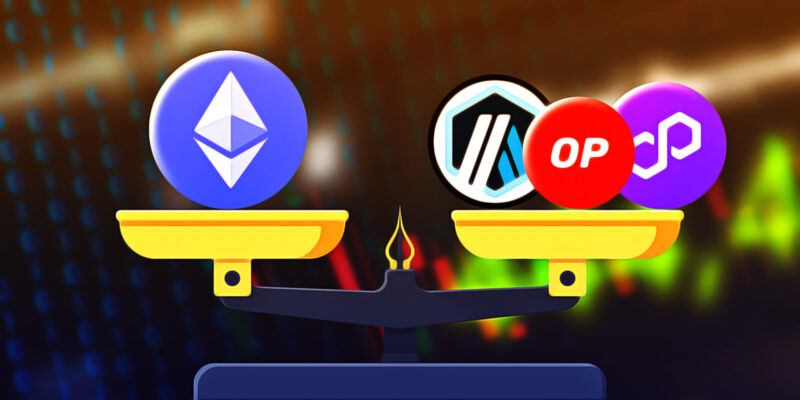- Innovative Layer 2 solutions like Arbitrum, Optimism, and Polygon address Ethereum’s scalability and transaction price issues.
Due to high transaction costs and constrained scalability, Ethereum, the top blockchain platform, has encountered difficulties recently. Layer 2 scaling alternatives have appeared, such as Arbitrum, Optimism and Polygon, to solve these problems. This article will contrast these options in this post, highlighting their main distinctions to assist one in selecting the best one for their project.
Scaling Solutions For Layer 2
By shifting transactions from the primary chain (Layer 1) to subsidiary layers (Layer 2), Layer 2 solutions seek to increase Ethereum’s scalability. Throughput is increased while transaction fees are decreased, and the security of Ethereum’s mainnet is preserved.
Polygon (formerly known as Matic Network)
Among these methods, Polygon stands out since it works as a sidechain as opposed to a conventional Layer 2 approach. Compared to Ethereum’s PoW, it uses the Proof of Stake (PoS) consensus process, which provides quicker transactions and reduced gas costs. Up to 65,000 transactions per second (TPS) may be processed using Polygon, which also supports EVM contracts and is compatible with Ethereum.
However, MATIC staking, which Polygon’s decentralization depends on, could not provide the same level of security as Ethereum’s extensive mining network.
Arbitrum And Optimism (Optimistic Rollups)
Both Optimistic Rollups, which interact closely with Ethereum’s main chain, include Arbitrum and Optimism. They use Ethereum’s consensus algorithm and security features, making them safe options.
Although optimistic rollups presume transaction legality and speed up transaction processing, they also extend the time needed to detect suspected fraud. Arbitrum employs multi-round fraud proofs that are processed off-chain, which increases efficiency but causes transaction verification to take a little longer. Significant reductions in Ethereum gas expenses are the goal of both methods.
Comparison Of Polygon, Optimism And Arbitrum
- On-chain verification, used by optimism, makes fraud-proof verification instantaneous but more expensive because of increased gas consumption. While taking longer but offering a bigger transaction capacity, Arbitrum handles suspicious transactions off-chain.
- Bridging and native tokens: While Optimism creates bridges depending on market demand, Arbitrum uses a permissionless bridge for all tokens. Regarding native tokens, while Optimism has unveiled the governance token OP, Arbitrum supports native ETH.
- Dependence on EVM is decreased by Arbitrum’s own virtual machine (Arbitrum Virtual Machine). EVM is essential to optimism, and it has plans to develop an EVM equivalent in the future.
- Ecosystem: Polygon is a great option for organizations looking for scalability and a mature environment because it has a sizable ecosystem with over 19,000 dApps. The ecosystems for Optimism and Arbitrum are smaller, with 15 and 228 dApps, respectively.
- Polygon offers the quickest token withdrawals through its PoS bridge, usually taking just three hours. Contrarily, withdrawals from Optimism and Arbitrum may take up to 7 days and 2 weeks, respectively.
- Decentralization: Ethereum’s decentralized mining network benefits Arbitrum and Optimism, offering strong security. Decentralization in Polygon is based on MATIC staking, which could not be as secure as Ethereum.
- Scalability and transaction costs: Polygon has modest fees ($0.1-0.5) and can handle up to 65,000 TPS. The 40,000 TPS offered by Arbitrum has gas prices ranging from $0.5-0.7. Optimism charges somewhat more ($0.6–$0.9) but can handle up to 2,000 TPS.
What Ethereum 2.0 Is For
Although Ethereum 2.0 is expected to increase its scalability, Layer 2 solutions won’t likely become obsolete. These methods will keep Ethereum efficient, avoid congestion, and provide distinctive features.
Selecting The Best Option
The exact needs and objectives of one’s project will determine which Layer 2 solution is best. Think about things like scalability, the scale of the ecosystem, withdrawal times, and security. Polygon is a good option if scalability and a developed ecosystem are important to them. Arbitrum is a well-liked choice for increased security and adaptability. In the end, one’s choice should be in line with the requirements of the project.
Conclusion
Innovative Layer 2 solutions like Arbitrum, Optimism, and Polygon address Ethereum’s scalability and transaction price issues. Before selecting the best option for one’s project, it is crucial to evaluate the objectives and needs. Each has advantages and disadvantages. With Ethereum 2.0 soon to be released, Layer 2 solutions are in a prime position to significantly improve the effectiveness and scalability of the Ethereum ecosystem.







Comments